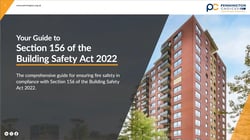Sign up to our newsletter
As of 1st October 2023, Section 156 of the Building Safety Act 2022 has introduced crucial changes to the way Responsible Persons (RPs) manage fire safety. Our recent webinar, which you can watch on-demand here, delved into the details of these regulations, shedding light on how they amend the Regulatory Reform (Fire Safety) Order 2005 (Fire Safety Order).
To make the requirements of Section 156 as straightforward as possible,  we’ve broken the legislation downinto 10 key takeaways that will ensure your buildings are compliant and safe. For a more exhaustive exploration of Section 156, download your free Guide to Section 156 of the Building Safety Act 2022 here.
we’ve broken the legislation downinto 10 key takeaways that will ensure your buildings are compliant and safe. For a more exhaustive exploration of Section 156, download your free Guide to Section 156 of the Building Safety Act 2022 here.
1. Record Fire Risk Assessments (FRAs) in full.
Previously, FRA guidance stated that only significant findings needed documentation, but Section 156 has brought in the requirement to record all FRAs in full. Organisations already meeting this standard may find no need for significant adjustments.
2. Record the name of the individual and/or organisation undertaking the fire risk assessment and share it with tenants.
The Responsible Person (RP) must record the name of any individual or organisation undertaking the FRA or FRA review, ensuring this information is shared with tenants.
3. Record fire safety arrangements.
Record your fire safety arrangements to show you have fire safety management practices in place, such as planning arrangements, controls, monitoring regimes, and preventative and protective measures. Create a fire safety procedure, management plan, or document that sets out how you’re meeting your obligations to demonstrate this.
Best practices from across the sector include using the BS 9997 as a useful framework for documenting this information. This is a great place to begin if you haven’t yet started recording your fire safety arrangements. It’s important to think about your roles and responsibilities, your approach to maintenance and testing, and how you plan for any upcoming requirements and performance evaluation.
4. Share relevant fire safety information with other responsible persons and tenants.
RPs must share contact information with other RPs and tenants. This includes the address of the RP and the preventative and protective measures that you have in place for your FRA. If your building has more than one RP, then it’s crucial that you’re sharing information with each other.
5. Identify other Responsible Persons/Accountable Persons and cooperate with them.
Make reasonable efforts to identify whether any other RPs share or have duties at the same premises and identify Accountable Persons (under the Building Safety Act in the case of higher-risk residential buildings 18m or at least 7 storeys) in the same building. It’s crucial that you cooperate by sharing relevant information, such as the FRA.
6. Departing Responsible Persons must share relevant fire safety information with incoming Responsible Persons.
If you are no longer going to be an RP for a building, make sure you share all relevant fire safety information with the incoming RP. For example, if you decide to sell one of your communal blocks, share things like your latest FRA, the identity of any person who assisted with the FRA, and the name and UK address of any RP.
7. Provide tenants with easy to understand, relevant fire safety information.
RPs must provide tenants with prescribed information in a format that is easy to understand (in addition to the information required under the Fire Safety (England) Regulations 2022). This will include the risks identified in your FRA, your identity as the RP, and any relevant fire safety measures that are in place.
8. Increased level of fines for some offences.
The amendments increase the level of fines, under Article 32 of the Fire Safety Order, for some offences, such as failure to comply with requirements imposed by a fire inspector, for example, not providing a copy of the FRA when requested.
9. Strengthens statutory guidance under Article 50 of the Fire Safety Order.
The amendments strengthen the status of statutory guidance issued under Article 50 of the Fire Safety Order, meaning you should comply with and follow the government guidance, because it can be used in court to establish whether you are in breach of the Fire Safety Order or not.
10. Ensure only competent persons undertake or review FRAs.
Current guidance states that you should appoint a fire risk assessor who is a competent individual. This will become a legal requirement at a later date with relevant guidance, making it mandatory to appoint a competent fire risk assessor.
.webp?width=600&height=150&name=Pennington%20Choices%20Logo%20(reduced).webp)





